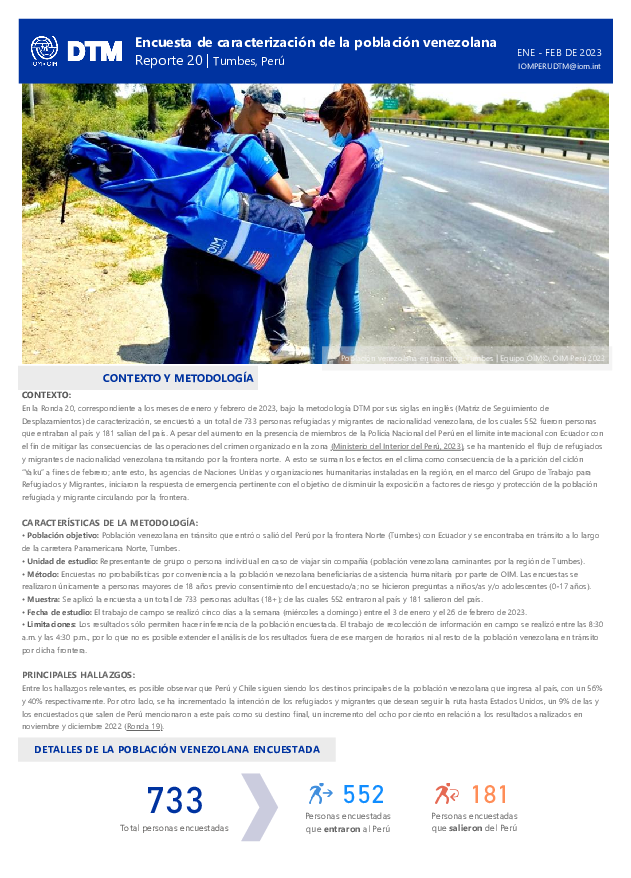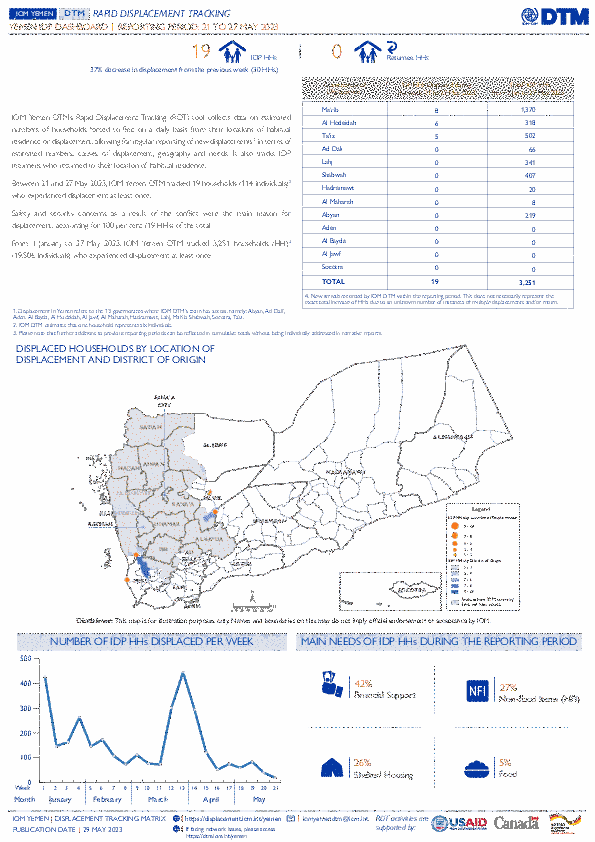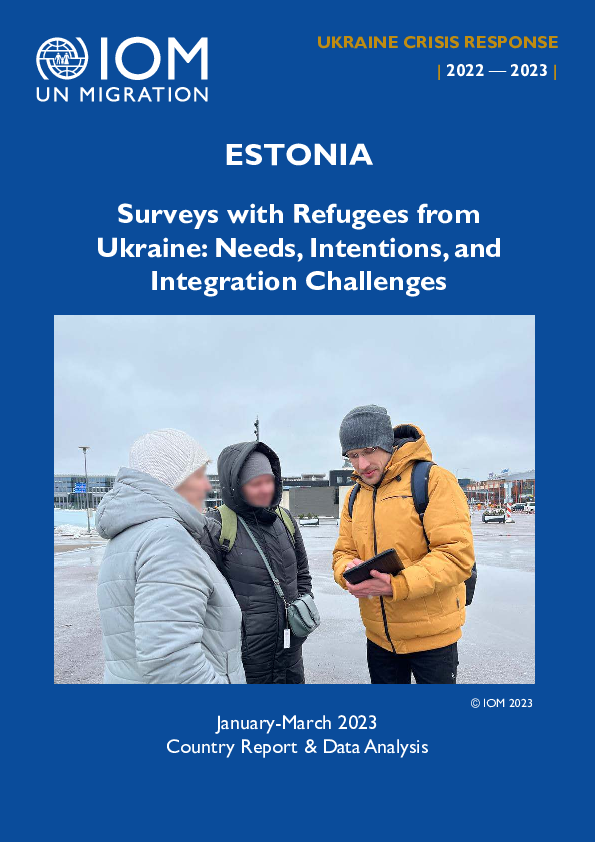-
Countries
-
Data and Analysis
-
Special Focus
-
Crisis Responses
Contact
DTM Sudan, DTMSudan@iom.int
Location
Sudan
Activity
- Mobility Tracking
- Baseline Assessment
Period Covered
Apr 15 2023 -May 29 2023
From 15 April 2023, armed clashes erupted between the Sudanese Armed Forces (SAF) and the Rapid Support Forces (RSF) in multiple cities across Sudan, including Khartoum, Al Fasher, Kebkabiya, Merowe, Nyala, Zalingi, Ag Geneina, and El Obeid. DTM Sudan has been receiving reports of widespread displacement across different states in Sudan due to the ongoing security situation.
— Since 15 April 2023, DTM estimates that approximately 1,210,214 individuals (242,666 households) have been displaced internally as a result of the conflict.
— Notably, the current estimate for displacement in the previous 45 days is greater than that of recorded displacement during the previous 4 years.
Due to the ongoing nature of the fighting, many areas reportedly remain inaccessible to humanitarian actors. DTM estimates of displacement are based on preliminary reports from field teams and should be taken as estimations only. Additional reports of displacement are likely to emerge as the situation becomes clearer.
The IDP caseload has sought shelter in locations across all of Sudan’s 18 states. IDPs have been originally displaced from six states, including Khartoum, West Darfur, South Darfur, North Darfur, North Kordofan, and Central Darfur.
Disclaimer: DTM Sudan notes that military clashes remain continuous in many areas across Sudan in particular in Khartoum and the Darfur region – limiting humanitarian access. Additionally, field teams have reported severe telecommunication and connectivity issues, as well as escalating economic pressures which have impacted the capacity for domestic travel. As such, DTM is currently conducting remote interviews with key informants across its network and is currently unable to engage in the additional verification of these figures. Data on flows into neighbouring countries is based on available information from DTM flow monitoring networks and secondary sources.
Population Groups
Survey Methodology
Unit of Analysis Or Observation
Type of Survey or Assessment
Keywords
Geographical Scope
Administrative boundaries with available data
The current dataset covers the following administrative boundaries

Contact
DTM Sudan; dtmsudan@iom.int
Language
English
Location
Sudan
Snapshot Date
May 29 2023
Activity
- Mobility Tracking
- Baseline Assessment
From 15 April 2023, armed clashes erupted between the Sudanese Armed Forces (SAF) and the Rapid Support Forces (RSF) in multiple cities across Sudan, including Khartoum, Al Fasher, Kebkabiya, Merowe, Nyala, Zalingi, Ag Geneina, and El Obeid. DTM Sudan has been receiving reports of widespread displacement across different states in Sudan due to the ongoing security situation.
- Since 15 April 2023, DTM estimates that approximately 1,210,214 individuals (242,666 households) have been displaced internally as a result of the conflict.
- Notably, the current estimate for displacement in the previous 45 days is greater than that of recorded displacement during the previous 4 years.
Due to the ongoing nature of the fighting, many areas reportedly remain inaccessible to humanitarian actors. DTM estimates of displacement are based on preliminary reports from field teams and should be taken as estimations only. Additional reports of displacement are likely to emerge as the situation becomes clearer.
The IDP caseload has sought shelter in locations across all of Sudan’s 18 states. IDPs have been originally displaced from six states, including Khartoum, West Darfur, South Darfur, North Darfur, North Kordofan, and Central Darfur.
Disclaimer: DTM Sudan notes that military clashes remain continuous in many areas across Sudan in particular in Khartoum and the Darfur region – limiting humanitarian access. Additionally, field teams have reported severe telecommunication and connectivity issues, as well as escalating economic pressures which have impacted the capacity for domestic travel. As such, DTM is currently conducting remote interviews with key informants across its network and is currently unable to engage in the additional verification of these figures. Data on flows into neighbouring countries is based on available information from DTM flow monitoring networks and secondary sources.
Contact
DTMChad@iom.int
Location
Chad
Activity
- Mobility Tracking
- Site Assessment
Period Covered
Nov 30 2022 -Jan 09 2023
This dataset contains the results of evaluations conducted between November 29, 2022 – January 9, 2023 in 245 locations. A slight increase in the number of displaced people was observed during this round 19 compared to the previous round (+6%). This is mainly explained by the displacements due to floods and insecurity during this period.
During this round, a total number of 255,054 individuals were displaced, including 207,691 internal displaced individuals, 28,660 returnees from abroad and 18,703 internal returnees.
Population Groups
Survey Methodology
Unit of Analysis Or Observation
Type of Survey or Assessment
Keywords
Geographical Scope
Administrative boundaries with available data
The current dataset covers the following administrative boundaries

Contact
DTM Cameroon, DTMCameroun@iom.int
Language
English
Location
Cameroon
Period Covered
May 23 2023
May 28 2023
Activity
- Mobility Tracking
- Event Tracking
Selon les informations reçues, Les localités de RANN et de GAMBAROU au Nigéria font face à l’insécurité avec
les enlèvements et incursion des groupes armés non-étatique (GANEs). A cela s’ajoute les attaques des
pachydermes (éléphants) qui détruisent de nombreux hectares des champs des populations au cours du mois de
mai 2023.
Face à cette montée d’insécurité et des attaques des pachydermes créant ainsi une situation de famine, les
populations des localités de Rann et de Gambarou au Nigeria ont été contraintes à se déplacer de manière
progressive depuis la date du 19 mai 2023 vers la localité de Chimtri dans l'arrondissement d'accueil de Makary,
département du Logone et Chari, région de l’Extrême Nord – Cameroun.
A ce jour l’on dénombre environ 107 ménages dont 856 individus réfugiés hors camp installés dans un site
spontané d’urgence.

Contact
Idiam Osorio, iosorio@iom.int
Language
Spanish
Location
Panama
Period Covered
Apr 01 2023
Apr 30 2023
Activity
- Flow Monitoring Survey
- Flow Monitoring
La provincia del Darién se ubica en la frontera este de Panamá, y su territorio forma parte de las rutas migratorias más utilizadas por personas en situación de movilidad humana por las Américas para migrar desde el sur hacia el norte del continente A su vez, esta ruta es conocida por ser altamente peligrosa debido a las características geográficas de la selva y la presencia de crimen organizado Las personas que la transitan se encuentran expuestas a riesgos varios como la trata de personas, tráfico ilícito, violencia basada en género, diversas formas de explotación y abuso El uso de estas rutas inseguras para llegar a destinos temporarios o finales plantea amenazas para la integridad, dignidad y la vida misma.

Contact
DTM Peru, IOMDTMPeru@iom.int
Language
Spanish
Location
Peru
Period Covered
Jan 01 2023
Feb 28 2023
Activity
- Flow Monitoring
En la Ronda 20, correspondiente a los meses de enero y febrero de 2023, bajo la metodología DTM por sus siglas en inglés (Matriz de Seguimiento de Desplazamientos) de caracterización, se encuestó a un total de 733 personas refugiadas y migrantes de nacionalidad venezolana, de los cuales 552 fueron personas que entraban al país y 181 salían del país. A pesar del aumento en la presencia de miembros de la Policía Nacional del Perú en el límite internacional con Ecuador con el fin de mitigar las consecuencias de las operaciones del crimen organizado en la zona (Ministerio del Interior del Perú, 2023), se ha mantenido el flujo de refugiados y migrantes de nacionalidad venezolana transitando por la frontera norte. A esto se suman los efectos en el clima como consecuencia de la aparición del ciclón “Yaku” a fines de febrero; ante esto, las agencias de Naciones Unidas y organizaciones humanitarias instaladas en la región, en el marco del Grupo de Trabajo para Refugiados y Migrantes, iniciaron la respuesta de emergencia pertinente con el objetivo de disminuir la exposición a factores de riesgo y protección de la población refugiada y migrante circulando por la frontera.

Contact
DTM Yemen, iomyemendtm@iom.int
Language
English
Location
Yemen
Period Covered
May 21 2023
May 27 2023
Activity
- Rapid Emergency Registration
- Mobility Tracking
IOM Yemen DTM’s Rapid Displacement Tracking (RDT) tool collects data on estimated numbers of households forced to flee on a daily basis from their locations of origin or displacement, allowing for regular reporting of new displacements in terms of estimated numbers, geography, and needs. It also tracks returnees who returned to their location of origin.
From 1 January to 27 May 2023, IOM Yemen DTM tracked 3,251 households (HH) (19,506 Individuals) who experienced displacement at least once.
Between 21 and 27 May 2023, IOM Yemen DTM tracked 19 households (114 individuals) displaced at least once. The majority of people moved into/within the following governorates and districts:
- Ma’rib (8 HHs) – Harib (6 HHs), Ma’rib City (1 HH), Ma’rib (1 HH) districts. Most displacements in the governorate originated from Ma’rib and Al Hodeidah.
- Al Hodeidah (6 HHs) – Hays (6 HHs) district. Most displacements in the governorate originated from Ta’iz and Al Hodeidah.
- Ta’iz (5 HHs) – Al Makha (5 HHs) district. All displacements in the governorate were internal.
The majority of people moved from the following governorates and districts:
- Ta’iz (8 HHs) – Maqbanah (8 HHs) district.
- Ma’rib (6 HHs) – Harib (6 HHs) district.
- Al Hodeidah (4 HHs) – Jabal Ras (3 HHs), Bajil (1 HH) districts.
Contact
DTM Yemen, iomyemendtm@iom.int
Location
Yemen
Activity
- Mobility Tracking
- Event Tracking
Period Covered
May 21 2023 -May 27 2023
From 1 January to 27 May 2023, IOM Yemen DTM tracked 3,251 households (HH) (19,506 Individuals) who experienced displacement at least once.
Between 21 and 27 May 2023, IOM Yemen DTM tracked 19 households (114 individuals) displaced at least once. The majority of people moved into/within the following governorates and districts:
- Ma’rib (8 HHs) – Harib (6 HHs), Ma’rib City (1 HH), Ma’rib (1 HH) districts. Most displacements in the governorate originated from Ma’rib and Al Hodeidah.
- Al Hodeidah (6 HHs) – Hays (6 HHs) district. Most displacements in the governorate originated from Ta’iz and Al Hodeidah.
- Ta’iz (5 HHs) – Al Makha (5 HHs) district. All displacements in the governorate were internal.
- Ta’iz (8 HHs) – Maqbanah (8 HHs) district.
- Ma’rib (6 HHs) – Harib (6 HHs) district.
- Al Hodeidah (4 HHs) – Jabal Ras (3 HHs), Bajil (1 HH) districts.
Population Groups
Survey Methodology
Unit of Analysis Or Observation
Type of Survey or Assessment
Keywords
Geographical Scope
Administrative boundaries with available data
The current dataset covers the following administrative boundaries

Contact
DTM Europe, DTMMediterranean@iom.int
Language
English
Location
Estonia
Period Covered
Jan 01 2023
Mar 31 2023
Activity
- Survey
- Flow Monitoring
This report is based on a survey of displacement patterns, needs and intentions conducted by IOM’s Displacement Tracking Matrix (DTM) in the 11 countries included in the Regional Response Plan for Ukraine in 2023: 6 countries neighbouring Ukraine – Belarus, Hungary, Poland, Republic of Moldova, Romania and Slovakia – and other 5 countries particularly impacted by the arrivals of refugees from Ukraine since the start of the war in February 2022 – Bulgaria, Czechia, Estonia, Latvia and Lithuania.
Estonia - Key findings:
- Top oblasts of origin: Kyiv City (13%), Khersonska (12%), Kharkivska (11%), Donetska (10%), Zaporizka (8%), Dnipropetrovska (8%).
- Intentions to move: no intention to move (88%), move to place of origin in Ukraine (3%), to another country (1%), where top two countries were Finland and Spain.
- Employment status: employed (36%), unemployed and looking for a job (33%), unemployed and not looking for a job (5%), retired (11%).
- Top needs upon return:* employment (27%), health services (26%), financial support (25%), documentation and registration (15%).
- Top areas of assistance received:* free transportation (86%), food products (70%), financial support (54%), long-term accommodation (33%).
- Top inclusion challenges:* employment (25%), language (24%), housing (17%), recognition of professional skills, diplomas (9%), financial issues (8%).
